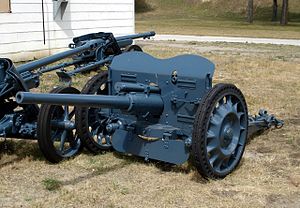|
47 mm APX anti-tank gun
The 47 mm APX anti-tank gun was a French anti-tank gun that saw service in the first years of the Second World War. DevelopmentIn the 1930s the French Army sought a replacement for the derivatives of the 75 mm mle 1897 field gun it used as an anti-tank gun. The soixante-quinze was an effective anti-tank gun but was heavy and much harder to conceal than the newer, small, high-velocity, small calibre anti-tank weapons. The chosen weapon was a design of the state-owned arsenal Atelier de Construction de Puteaux workshop (abbreviated to APX) located in Puteaux, Paris, and was named the canon de 47 mm semi-automatique mle 1937. A similar model designated the canon de 47 mm semi-automatique mle 1939 was also produced. Both were efficient weapons, especially given the thin armour of contemporary German tanks. The gun could pierce 60 mm (2.4 in) at 550 meters (600 yd) or 80 mm (3.1 in) at 180 meters (200 yd).[1] Unfortunately for France, the 47mm SA mle 1937 and 47mm SA mle 1939 were still rare weapons at the time of the Battle of France. Foreign useExamples captured by the German forces were used under the name 4.7 cm Pak 181(f) for the mle 1937 and 4.7 cm Pak 183(f) for the mle 1939. The guns were used in Atlantic Wall fortifications and armed a number of their Panzerjäger self-propelled tank destroyers.
Variants
See also
References
Sources
Wikimedia Commons has media related to 47 mm APX anti-tank gun. |
||||||||||||||||||||||||||||||||||||||||||||||||||||||||||
